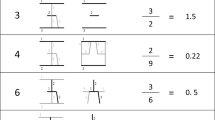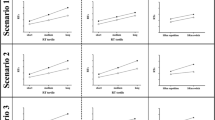Abstract
In line with the suggestion that the strength of the spatial numerical association of response codes (SNARC) effect was time dependent, the aim of the present study was to assess whether the association strength depends on the processing time of numerical quantity and/or of the time to initiate responses. More specifically, we examined whether and how the SNARC effect could be modulated by number format and effector type. Experiment 1 compared the effect induced by Arabic numbers and number words on the basis of saccadic responses in a parity judgment task. Indeed, previous studies have shown that Arabic numbers lead to faster processing than number words. The results replicated the SNARC effect with Arabic numbers, but not with number words. Experiment 2 was similar to Experiment 1, but this time manual responses (i.e., responses far slower than saccadic ones) were recorded. A strong SNARC effect was observed for both number formats. Further analyses revealed a correlation between mean individual response times and the strength of the SNARC effect. We proposed that the initiation times for saccadic responses may be too short for the SNARC effect to appear, in particular with the written number format for which activation of magnitude takes time. We conclude in terms of time variations resulting from processing specificities related with number format, effector type and also individual reaction and processing speed.




Similar content being viewed by others
References
Brysbaert, M. (2018) Numbers and language: What’s new in the past 25 years?. In A. Henik & W. Fias (Eds.), Heterogeneity of Function in Numerical Cognition. Amsterdam: Elsevier Academic Press.
Bulf, H., Cassia, V. M., & de Hevia, M. D. (2014). Are numbers, size and brightness equally efficient in orienting visual attention? Evidence from an eye-tracking study. PLoS One, 9(6), e99499. https://doi.org/10.1371/journal.pone.0099499.
Bulf, H., de Hevia, M. D., & Cassia, V. M. (2016). Small on the left, large on the right: Numbers orient visual attention onto space in preverbal infants. Developmental Science, 19(3), 394–401.
Bull, R., Cleland, A. A., & Mitchell, T. (2013). Sex differences in the spatial representation of number. Journal of Experimental Psychology: General, 142(1), 181.
Carling, K. (2000). Resistant outlier rules and the non-Gaussian case. Computational Statistics & Data Analysis, 33(3), 249–258.
Casarotti, M., Michielin, M., Zorzi, M., & Umiltà, C. (2007). Temporal order judgment reveals how number magnitude affects visuospatial attention. Cognition, 102(1), 101–117.
Cipora, K., & Nuerk, H. C. (2013). Is the SNARC effect related to the level of mathematics? No systematic relationship observed despite more power, more repetitions, and more direct assessment of arithmetic skill. Quarterly journal of experimental psychology, 66(10), 1974–1991.
Coltheart, M., Rastle, K., Perry, C., Langdon, R., & Ziegler, J. (2001). DRC: a dual route cascaded model of visual word recognition and reading aloud. Psychological Review, 108(1), 204.
Damian, M. F. (2004). Asymmetries in the processing of Arabic digits and number words. Memory & Cognition, 32(1), 164–171.
Dehaene, S., Bossini, S., & Giraux, P. (1993). The mental representation of parity and number magnitude. Journal of Experimental Psychology: General, 122(3), 371.
Fabbri, M. (2013). Finger counting habits and spatial-numerical association in horizontal and vertical orientations. Journal of Cognition and Culture, 13(1–2), 95–110.
Fattorini, E., Pinto, M., Rotondaro, F., & Doricchi, F. (2015). Perceiving numbers does not cause automatic shifts of spatial attention. Cortex, 73, 298–316.
Fias, W. (1996). The importance of magnitude information in numerical processing: Evidence from the SNARC effect. Mathematical Cognition, 2(1), 95–110.
Fias, W. (2001). Two routes for the processing of verbal numbers: Evidence from the SNARC effect. Psychological Research Psychologische Forschung, 65(4), 250–259.
Fischer, M. H. (2001). Number processing induces spatial performance biases. Neurology, 57(5), 822–826.
Fischer, M. H. (2008). Finger counting habits modulate spatial-numerical associations. Cortex, 44(4), 386–392.
Fischer, M. H., Castel, A. D., Dodd, M. D., & Pratt, J. (2003). Perceiving numbers causes spatial shifts of attention. Nature Neuroscience, 6(6), 555–556.
Fischer, M. H., Shaki, S., & Cruise, A. (2009). It takes just one word to quash a SNARC. Experimental Psychology, 56(5), 361–366.
Fischer, M. H., Warlop, N., Hill, R. L., & Fias, W. (2004). Oculomotor bias induced by number perception. Experimental Psychology, 51(2), 91–97.
Fitousi, D., Shaki, S., & Algom, D. (2009). The role of parity, physical size, and magnitude in numerical cognition: The SNARC effect revisited.. Perception & Psychophysics, 71(1), 143–155.
Ford, N., & Reynolds, M. G. (2016). Do Arabic numerals activate magnitude automatically? Evidence from the psychological refractory period paradigm. Psychonomic Bulletin & Review, 23(5), 1528–1533.
Gevers, W., Verguts, T., Reynvoet, B., Caessens, B., & Fias, W. (2006). Numbers and space: acomputational model of the SNARC effect. Journal of Experimental Psychology: Human Perception and Performance, 32(1), 32.
Glaser, W. R. (1992). Picture naming. Cognition, 42(1), 61–105.
Hartmann, M., & Fischer, M. H. (2016). Exploring the numerical mind by eye-tracking: a special issue. Psychological Research Psychologische Forschung, 80, 325–333.
Hesse, P. N., Fiehler, K., & Bremmer, F. (2015). SNARC Effect in Different Effectors. Perception, 45(1–2), 180–195.
Hines, T. M. (1990). An odd effect: Lengthened reaction times for judgments about odd digits. Memory & Cognition, 18(1), 40–46.
Keus, I. M., Jenks, K. M., & Schwarz, W. (2005). Psychophysiological evidence that the SNARC effect has its functional locus in a response selection stage. Cognitive Brain Research, 24(1), 48–56.
Lindemann, O., Alipour, A., & Fischer, M. H. (2011). Finger counting habits in middle eastern and western individuals: an online survey. Journal of Cross-Cultural Psychology, 42(4), 566–578.
Loetscher, T., Bockisch, C. J., & Brugger, P. (2008). Looking for the answer: The mind’s eye in number space. Neuroscience, 151(3), 725–729.
Loetscher, T., Bockisch, C. J., Nicholls, M. E., & Brugger, P. (2010). Eye position predicts what number you have in mind. Current Biology, 20(6), R264–R265.
Loetscher, T., Schwarz, U., Schubiger, M., & Brugger, P. (2008). Head turns bias the brain’s internal random generator. Current Biology, 18(2), R60–R62.
Macnamara, A., Keage, H. A., & Loetscher, T. (2018). Mapping of non-numerical domains on space: a systematic review and meta-analysis. Experimental Brain Research, 236, 335–346. https://doi.org/10.1007/s00221-017-5154-6.
Mock, J., Huber, S., Klein, E., & Moeller, K. (2016). Insights into numerical cognition: Considering eye-fixations in number processing and arithmetic. Psychological Research Psychologische Forschung, 80(3), 334–359.
Myachykov, A., Cangelosi, A., Ellis, R., & Fischer, M. H. (2015). The oculomotor resonance effect in spatial–numerical mapping. Actapsychologica, 161, 162–169.
Myachykov, A., Ellis, R., Cangelosi, A., & Fischer, M. H. (2016). Ocular drift along the mental number line. Psychological Research Psychologische Forschung, 80(3), 379–388.
Nuerk, H. C., Iversen, W., & Willmes, K. (2004). Notational modulation of the SNARC and the MARC (linguistic markedness of response codes) effect. Quarterly Journal of Experimental Psychology Section A, 57(5), 835–863.
Nuerk, H. C., Wood, G., & Willmes, K. (2005). The universal SNARC effect: The association between number magnitude and space is amodal. Experimental Psychology, 52(3), 187–194.
Roettger, T. B., & Domahs, F. (2015). Grammatical number elicits SNARC and MARC effects as a function of task demands. The Quarterly Journal of Experimental Psychology, 68(6), 1231–1248.
Rugani, R., & de Hevia, M. D. (2017). Number-space associations without language: Evidence from preverbal human infants and non-human animal species. Psychonomic Bulletin & Review, 24(2), 352–369.
Schwarz, W., & Keus, I. M. (2004). Moving the eyes along the mental number line: Comparing SNARC effects with saccadic and manual responses. Perception & Psychophysics, 66(4), 651–664.
Shaki, S., Fischer, M. H., & Petrusic, W. M. (2009). Reading habits for both words and numbers contribute to the SNARC effect. Psychonomic Bulletin & Review, 16(2), 328–331.
van Dijck, J. P., Abrahamse, E. L., Acar, F., Ketels, B., & Fias, W. (2014). A working memory account of the interaction between numbers and spatial attention. The Quarterly Journal of Experimental Psychology, 67(8), 1500–1513.
Viarouge, A., Hubbard, E. M., & McCandliss, B. D. (2014). The cognitive mechanisms of the SNARC effect: An individual differences approach. PLoS ONE, 9(4), e95756. https://doi.org/10.1371/journal.pone.0095756.
Wood, G., Nuerk, H. C., & Willmes, K. (2006). Crossed Hands and the Snarc Effect: A failure to Replicate Dehaene, Bossini and Giraux (1993). Cortex, 42(8), 1069–1079.
Wood, G., Willmes, K., Nuerk, H.-C., & Fischer, M. H. (2008). On the cognitive link between space and number: A meta-analysis of the SNARC effect. Psychology Science, 50(4), 489–525.
Zebian, S. (2005). Linkages between number concepts, spatial thinking, and directionality of writing: The SNARC effect and the reverse SNARC effect in English and Arabic monoliterates, biliterates, and illiterate Arabic speakers. Journal of Cognition and Culture, 5(1), 165–190.
Acknowledgements
We warmly thank all reviewers for considering this paper. We thank Dr Christelle Lemoine-Lardennois and Dr Alexandra Fayel for their technical skills as well as all participants who volunteered for this study.
Author information
Authors and Affiliations
Corresponding author
Ethics declarations
Conflict of interest
The authors declare that they have no conflict of interest. All procedures performed in studies involving human participants were in accordance with the ethical standards of the institutional research committee and with the 1964 Helsinki Declaration and its later amendments or comparable ethical standards. Informed consent was obtained from all individual participants included in the study.
Rights and permissions
About this article
Cite this article
Pressigout, A., Charvillat, A., Mersad, K. et al. Time dependency of the SNARC effect for different number formats: evidence from saccadic responses. Psychological Research 83, 1485–1495 (2019). https://doi.org/10.1007/s00426-018-1010-y
Received:
Accepted:
Published:
Issue Date:
DOI: https://doi.org/10.1007/s00426-018-1010-y




